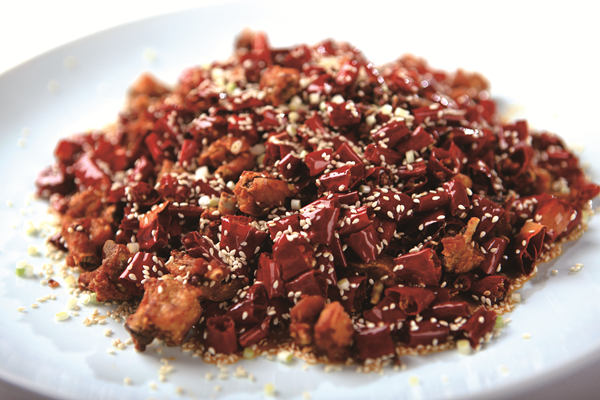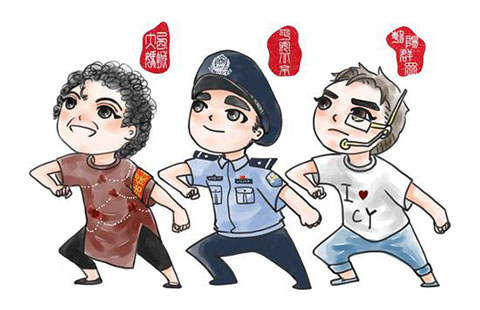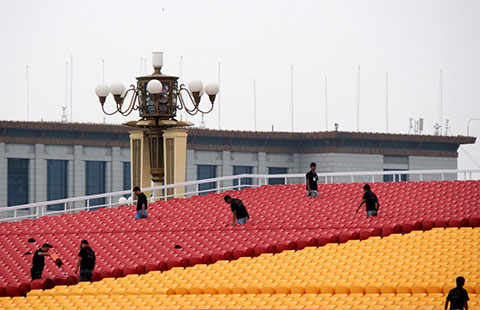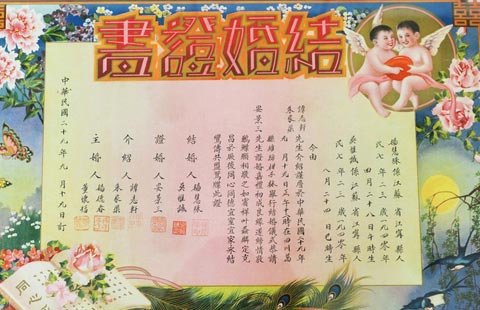Not your father’s Chinese restaurant
Updated: 2015-08-22 02:37
By HEZI JIANG(China Daily USA)
|
|||||||||
 |
|
Chongqing Spicy Chicken is a popular dish at the Meizhou Dongpo Restaurant in Beverly Hills, California. Meizhou Dongpo is a Chinese restaurant chain that’s expanding overseas and plans to have five restaurants in the US by next year. PROVIDED TO CHINA DAILY |
Their own entrees
“We realized Americans prefer that all the main dishes be served at the same time because everyone has their own entree,” he said. “Chinese like the dishes to be served right when it’s ready because they share the dishes. Our servers would put down a mark on the order letting the kitchen know whether the customers are Chinese or American so that we can accommodate better.”
With revenue up 20 percent over last year, Meizhou Dongpo is more confident about what it is doing.
Instead of bringing shifts of chefs in from China, it has developed a system of sending Los Angeles local chefs to the Beijing headquarters, where they undergo professional training and a challenging test before graduating. The system raises the stability of chefs and food quality, Wang said.
Four new locations — three in the Greater Los Angeles Area and a flagship in Las Vegas — and a central kitchen in Baldwin Park are being developed at the same time, with an Arcadia location planned to open by the end of the year.
Authentic vs fusion
“For the 18 years the chef worked here, he barely had eaten at other restaurants. The servers had never been served properly before,” Jonathan Ho said, shaking his head. Ho is the new owner of the restaurant Shanghai Cuisine in Manhattan’s Chinatown.
Ho brought his chef to RedFarm, a modern Chinese restaurant owned by Ed Schoenfeld, a pioneer in the movement to bring authentic regional Chinese dishes to New York in the 1970s.
“For lots of Chinese chefs, the problem is not their crafts or experience, but their vision,” said Ho. “Cooking is an art. A chef has to be aware of what other chefs are doing, while broadening his vision by listening to music, learning about art and more. Cooking is not a static action of turning the food in the wok.”
Ho served the waiters at Shanghai Cuisine himself to show them how fine-dining restaurants treat their customers. With a soon-to-be updated interior and strict staff training, he wants to keep serving authentic Shanghai food and providing an upscale experience.
“Now diners have very high standards for restaurants. Every detail in my restaurant represents my attitude toward food,” he said.
“Two ways we can redefine Chinese cuisine: First, stick with the most traditional and authentic Chinese food and make it better; second, innovation, play with it,” Ho said. His theory matched with what the National Restaurant Association of America got through surveying 1,300 professional chefs and members of the American Culinary Federation.
On the 2015 Menu Trends to Watch list, “going global” stands with five others, like local sourcing and gourmet kids’ dishes. And under the big umbrella of American restaurants going global, “micro-trending in this category is fusion cuisines, as well as authentic and regional, underscoring the breadth and depth of flavors being explored”.
After taking over Shanghai Cuisine last October, Ho met a partner and decided they could open another Chinese restaurant to try out fusion cuisine. In March, Carma Asian Tapas opened its doors in New York.
With Carma, Ho is aiming for a “a playful place. A lab”.
On the menu, there is the crispy wosum salad, made with lotus root and fresh shredded wosum — a vegetable most Americans had never tasted, and creative Peking duck tacos.
“Chinese chefs are becoming much less provincial, much more worldly. They are seeing other kinds of foods. Now you see Chinese people adding all kinds of food to their repertoire. They are feeling the influence of other cultures,” said Schoenfeld, named “the walking encyclopedia of Chinese food” by eater.com.
“Low price, big portions and bad service are what Americans think of Chinese restaurants,” Ho said. “We are challenging this impression.”
Located in the hip West Village, Carma Asian Tapas has indoor seating, a full bar and a beautiful courtyard looking like a small siheyuan, or historical Chinese quadrangle.
On a Friday evening, the courtyard is packed. At one table, six ladies are having a girls’ night out. In a combination of Cantonese and English, they spoke highly of the beef noodles.
Separated by blooming begonias, at the table next to the women, are a senior couple enjoying Xiao Long Bao and Peking duck tacos. House water is served in classic French restaurant glass bottles. Crystal ball string lights illuminate the yard when night falls, and the pathos plants stretch their short veins on the wall.
- Tsipras formally resigns, requesting snap general elections
- China-Russia drill not targeting 3rd party
- UK, France boost security
- China demands Japan face history after Abe's wife visits Yasukuni Shrine
- DPRK deploys more fire units to frontlines with ROK
- DPRK, ROK trade artillery, rocket fire at border

 Across America over the week (Aug 14 - Aug 20)
Across America over the week (Aug 14 - Aug 20)
 Stars in their eyes: leaders in love
Stars in their eyes: leaders in love
 A survival guide for singles on Chinese Valentine’s Day
A survival guide for singles on Chinese Valentine’s Day
 Beijing police publishes cartoon images of residents who tip off police
Beijing police publishes cartoon images of residents who tip off police
 Rare brown panda grows up in NW China
Rare brown panda grows up in NW China
 Putin rides to bottom of Black Sea
Putin rides to bottom of Black Sea
 The changing looks of Beijing before V Day parade
The changing looks of Beijing before V Day parade
 Nanjing displays ancient marriage, divorce certificates
Nanjing displays ancient marriage, divorce certificates
Most Viewed
Editor's Picks

|

|

|

|

|

|
Today's Top News
Emissions data won't change China policy
Preparations shutter Forbidden City, other major tourist spots
President Xi Jinping calls for crews not to ease up
Chemical plants to be relocated in blast zone
Asian sprinters on track to make some big strides
Jon Bon Jovi sings in Mandarin for Chinese Valentine's Day
Tsipras formally resigns, requesting snap general elections
DPRK deploys more fire units to frontlines with ROK
US Weekly

|

|







